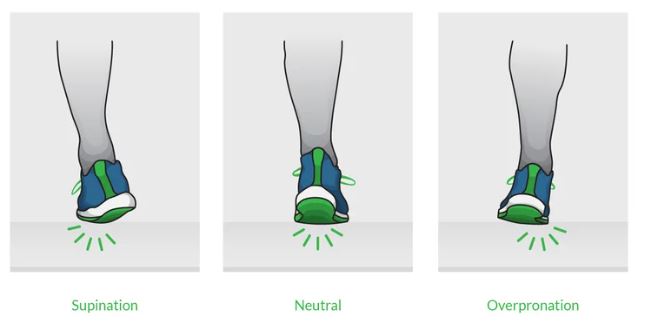Pronation Explained: How to Identify Your Gait and Choose the Right Running Shoes
Understanding Pronation: A Comprehensive Overview
Running is one of the most accessible forms of exercise, but like any physical activity, it requires awareness of biomechanics to ensure comfort and minimize injury. One often-discussed factor in running form is pronation. For those who aren’t experiencing any discomfort, there’s usually no need to analyze your gait. However, if you’re dealing with pain or inefficiency during runs, it’s worth exploring how your feet interact with the ground.
The Mechanics of Pronation
Pronation describes the natural movement of the foot as it rolls inward during walking or running. As your heel strikes the ground, your arch flattens slightly to help absorb the impact. This process allows for even weight distribution and shock absorption. Everyone pronates to some extent; it’s an essential part of locomotion.
There are three primary types of pronation:
- Neutral pronation involves a balanced inward roll of the foot.
- Overpronation refers to an exaggerated inward roll, typically causing extra pressure on the inside of the foot.
- Underpronation (or supination) happens when the foot rolls outward, placing more weight on the outer edge.

Why Pronation Matters
Understanding your pronation type is important because it affects your overall biomechanics. Improper pronation may lead to uneven weight distribution and instability, which could contribute to discomfort or injury. While it’s not always the root cause of problems, abnormal pronation can affect your stride efficiency, joint stress, and even posture.
Researchers and professionals in sports science have delved into this issue to improve shoe design and develop corrective strategies for runners. Footwear innovations now cater to various pronation patterns to provide the support runners need.
Determining Your Pronation Type
The most reliable way to assess pronation is through dynamic evaluation. Static tests can provide clues, but pronation is a motion-related issue and should be observed in action. Here are several ways to determine your pronation pattern:
Professional Gait Analysis
The most accurate assessments are conducted by podiatrists or gait specialists. These professionals use treadmills, cameras, and motion analysis software to evaluate how your feet behave while walking or running.
In-Store Gait Evaluations
Many specialty running stores offer gait analysis services using in-store treadmills and video feedback. Although not as comprehensive as a medical assessment, this method still provides useful insight into foot mechanics.
Self-Assessment Techniques
While convenient, DIY methods are far less reliable. Studies show that runners self-diagnose foot types correctly less than half the time. Common self-tests include the wet footprint test and observing wear patterns on old shoes. However, these methods don’t fully account for dynamic movement or joint alignment.
The Wet Foot Test
This popular home test involves wetting your foot and stepping onto a dry surface, such as a brown paper bag. By analyzing the shape of your footprint, you can make a general assumption about your arch height, which loosely correlates with pronation:
- A full imprint suggests flat feet and potential overpronation.
- A moderate imprint typically reflects a neutral gait.
- A thin or fragmented imprint indicates a high arch, often associated with underpronation.
While useful for a quick check, the wet test does not capture joint angles or motion and should only be used as a preliminary assessment.

Foot Posture Index (FPI)
The Foot Posture Index offers a more comprehensive static evaluation by scoring several aspects of foot alignment. It involves measuring the tilt of the heel, height of the arch, and other characteristics, assigning a score that categorizes the foot as pronated, neutral, or supinated.
Although this test provides deeper insights than the wet test, it still lacks the dynamic component of gait. It’s best performed by trained professionals and should complement, not replace, motion analysis.
Footwear and Pronation
Choosing the right running shoes can alleviate problems related to pronation. Footwear selection depends on the type of pronation and the severity of any biomechanical issues. Runners who are comfortable in their current shoes with no discomfort likely don’t need to change anything. But for those experiencing pain, appropriate footwear can be essential.
Categories of Running Shoes
Running shoes fall into three primary categories, each designed to address different pronation needs:
Neutral Shoes
These are intended for runners with neutral pronation or underpronation. They offer cushioning without structural features that alter foot motion. The emphasis is on comfort and shock absorption.
Stability Shoes
Stability models are built for runners with mild to moderate overpronation. These shoes include features like medial posts or firmer foam on the arch side to prevent excessive inward rolling. They strike a balance between support and cushioning.
Motion Control Shoes
Though less common today, motion control shoes cater to runners with severe overpronation. They incorporate robust support structures, such as firm medial posts and stiff heel counters, to minimize foot collapse and promote proper alignment.
Importance of Support Based on Speed
Supportive elements in shoes are particularly important for daily runs at slower speeds. When running fast, ground contact time is shorter, and less support is needed. That’s why racing and tempo shoes often lack stability features.
Design Elements in Stability Footwear
Modern stability shoes integrate both structural design and proprietary technologies. These elements are combined to control motion without compromising comfort.
Heel Counters
Stiff and padded heel counters secure the rearfoot and reduce excess movement. Internal or external reinforcements enhance fit and stability. In shoe testing, the stiffness of heel counters is graded to help runners choose the right level of support.

Dual-Density Midsoles
These midsoles use foams of varying firmness to guide foot motion. The firmer material is often placed under the arch or along the medial side to counter overpronation. Variants like Hoka’s J-Frame or H-Frame use creative shapes to provide this support.
Medial Posts
These dense foam or plastic components, positioned under the arch, reduce the degree of inward roll. Although used less frequently today, they’re still present in certain stability models and provide essential support for severe pronators.
Shoe Geometry
Several geometric features help enhance stability:
- Sidewalls: Raised midsole sections that cradle the foot.
- Heel bevels: Curved heel designs that soften landings.
- Sole flares: Protrusions on the lateral or medial sides to stabilize specific landing patterns.
- Straight lasts: Flatter midfoot shapes that provide a stable platform.
Outsole and Midsole Width
A wider shoe base, particularly in the heel and forefoot, increases ground contact and enhances balance. Stability shoes often have full-contact outsoles to minimize wobbling and maintain consistent support through the gait cycle.
Midsole Stiffness
Shoes with firmer or stiffer midsoles limit unwanted foot movement. This stiffness is measured by bending and twisting the shoe, testing both longitudinal and torsional resistance. High stiffness scores often correspond to enhanced stability.
Upper Construction
Overlays and structured uppers contribute to foot containment. Although not the primary stability element, a reinforced upper can reduce unwanted lateral movement and improve lockdown.
Technologies by Major Shoe Brands
Many footwear companies have introduced proprietary technologies to improve support for overpronators. These designs usually incorporate combinations of the geometric and structural elements discussed above.
Brooks GuideRails
This system uses dual foam rails to guide the foot and prevent excessive motion. The inner rail limits inward roll, while the outer rail supports heel alignment. Shoes with this technology are marked with “GTS” (Go-To-Stability) in their names.
Altra GuideRail
Altra’s system emphasizes medial support with a raised and firm section of foam on the inner side of the shoe. This helps correct overpronation without the need for posts or plates.
Selecting the Right Shoe
If you’re purchasing running shoes and don’t have access to a professional assessment, base your decision on comfort, previous experience, and observational methods like the wet test. The chart below outlines a basic guideline:
- Overpronators: Look for stability or motion control shoes.
- Neutral pronators: Neutral shoes are suitable.
- Underpronators (supinators): Despite the lack of dedicated shoes, most supinators do well with well-cushioned neutral models.
When in doubt, try multiple options and assess how your body responds to each. Pain-free running is the ultimate goal.
Final Thoughts
While pronation is a complex and often misunderstood subject, understanding its role in running mechanics can help prevent injury and improve comfort. Proper shoe selection is a key element of this process, and recognizing the differences between neutral, stability, and motion control footwear is critical.
Consulting a specialist remains the best way to understand your personal biomechanics. However, with some knowledge and self-awareness, you can make informed choices that keep you running comfortably and efficiently.







